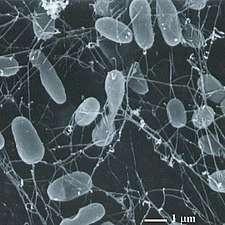Pyrolobus fumarii
Pyrolobus fumarii, (literally the "firelobe of the chimney"), is a species of archaea known for its ability to live at extremely high temperatures that kill most organisms.[1][2]
| Pyrolobus fumarii | |
|---|---|
 | |
| Scientific classification | |
| Domain: | |
| Phylum: | |
| Class: | |
| Order: | |
| Family: | |
| Genus: | Pyrolobus |
| Binomial name | |
| Pyrolobus fumarii Blöch, Rachel, Burggraf, Hafenbradl, Jannasch & Stetter, 1997 | |
It was first discovered in 1997 in a black smoker hydrothermal vent at the Mid-Atlantic Ridge, setting the upper temperature threshold for known life to exist at 113°C (235.4°F), but more recently Methanopyrus kandleri has been discovered which can survive temperatures up to 122°C. (251.6°F) [3][4] The species "freezes" or solidifies and ceases growth at temperatures of 90°C (194°F) and below.[5]
Strain 121, a microbe from the same family found at a vent in the Pacific Ocean, survived and multiplied during a 10-hour interval spent at 121°C (249.8°F) in an autoclave.[3]
References
- C.Michael Hogan. 2010. Extremophile. eds. E.Monosson and C.Cleveland. Encyclopedia of Earth. National Council for Science and the Environment, washington DC
- Joseph E. Armstrong. 2014. How the Earth Turned Green: A Brief 3.8-Billion-Year History of Plants. University of Chicago Press.
- Davison, Anna (26 June 2008). "The most extreme life-forms in the universe". NewScientist.com news service. Retrieved 2008-06-26.
- Blöchl E; Rachel R; Burggraf S; Hafenbradl D; et al. (February 1997). "Pyrolobus fumarii, gen. and sp. nov., represents a novel group of archaea, extending the upper temperature limit for life to 113 degrees C.". Extremophiles : Life Under Extreme Conditions. 1 (1): 14–21. doi:10.1007/s007920050010. PMID 9680332.
- Joseph E. Armstrong. 2014. How the Earth Turned Green: A Brief 3.8-Billion-Year History of Plants. University of Chicago Press.
Further reading
- Anderson, Iain; Goker, Markus; Nolan, Matt; Lucas, Susan; et al. (2011). "Complete genome sequence of the hyperthermophilic chemolithoautotroph Pyrolobus fumarii type strain (1AT)". Standards in Genomic Sciences. 4 (3): 381–392. doi:10.4056/sigs.2014648. PMC 3156397. PMID 21886865.
- Goncalves, Luis; Lamosa, Pedro; Huber, Robert; Santos, Helena (20 Feb 2008). "Di-myo-inositol phosphate and novel UDP-sugars accumulate in the extreme hyperthermophile Pyrolobus fumarii". Extremophiles. 12 (3): 383–389. doi:10.1007/s00792-008-0143-0. PMID 18286223.